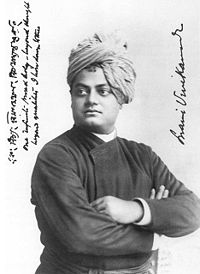15. क्रमान्यत्वं परिणामान्यतेवे हेतुः ॥१५॥
kramānyatvaṁ pariṇāmānyateve hetuḥ ||15||
The succession of changes is the cause of manifold evolution.
16. परिणामत्रयसंयमाततीतानागत ज्ञानम् ॥१६॥
pariṇāmatraya-saṁyamāt-atītānāgata jñānam ||16||
By making Samyama on the three sorts of changes comes the knowledge of past and future.
We must not lose sight of the first definition of Samyama. When the mind has attained to that state when it identifies itself with the internal impression of the object, leaving the external, and when, by long practice, that is retained by the mind, and the mind can get into that state in a moment, that is Samyama. If a man in that state wants to know the past and future he has to make a Samyama on the changes in the Samskaras. Some are working now at present, some have worked out, and some are waiting to work; so by making a Samyama on these he knows the past and future.
17. शब्दार्थप्रत्ययामामितरेतराध्यासात्संकरः तत्प्रविभागसंयमात् सर्वभूतरुतज्ञानम् ॥१७॥
śabdārtha-pratyayāmām-itaretarādhyāsāt-saṁkaraḥ tat-pravibhāga-saṁyamāt sarvabhūta-ruta-jñānam ||17||
By making Samyama on word, meaning, and knowledge, which are ordinarily confused, comes the knowledge of all animal sounds.
The word represents the external cause, the meaning represents the internal vibration that travels to the brain through the channels of the Indriyas, conveying the external impression to the mind, and knowledge represents the reaction of the mind, with which comes perception. These three confused, make our sense objects. Suppose I hear a word; there is first the external vibration, next the internal sensation carried to the mind by the organ of hearing, then the mind reacts, and I know the word. The word I know is a mixture of the three, vibration, sensation, and reaction. Ordinarily these three are inseperable; but by practice the Yogi can separate them. When a man has attained to this, if he makes a Samyama on any sound, he understands the meaning which that sound was intended to express, whether it was made by man or by any other animal.
18. संस्कारसाक्षात्करणात् पूर्वजातिज्ञानम् ॥१८॥
saṁskāra-sākṣātkaraṇāt pūrva-jāti-jñānam ||18||
By perceiving the impressions, knowledge of past life.
Each experience that we have comes in the form of a wave in the Chitta, and this subsides and becomes finer and finer, but is never lost. It remains there in minute form, and if we can bring this wave up again, it becomes memory. So, if the Yogi can make a Samyama on these past impressions in the mind, he will begin to remember all his past lives.
19. प्रत्ययस्य परचित्तज्ञानम् ॥१९॥
pratyayasya para-citta-jñānam ||19||
By making Samyama on the signs in another’s both knowledge of that mind comes.
Suppose each man has particular signs on his body, which differentiate him from others; when the Yogi makes a Samyama on these signs peculiar to a certain man he knows the nature of the mind of that person.
20. न च तत् सालम्बनं तस्याविषयी भूतत्वात् ॥२०॥
na ca tat sālambanaṁ tasya-aviṣayī bhūtatvāt ||20||
But not its contents, that not being the object of the Samyama.
He would not know the contents of the mind by making a Samyama on the body. There would be required a twofold Samyama, first on the signs in the body, and then on the mind itself. The Yogi would then know everything that is in that mind, past, present, and future.
 Swami Vivekananda
Swami Vivekananda
